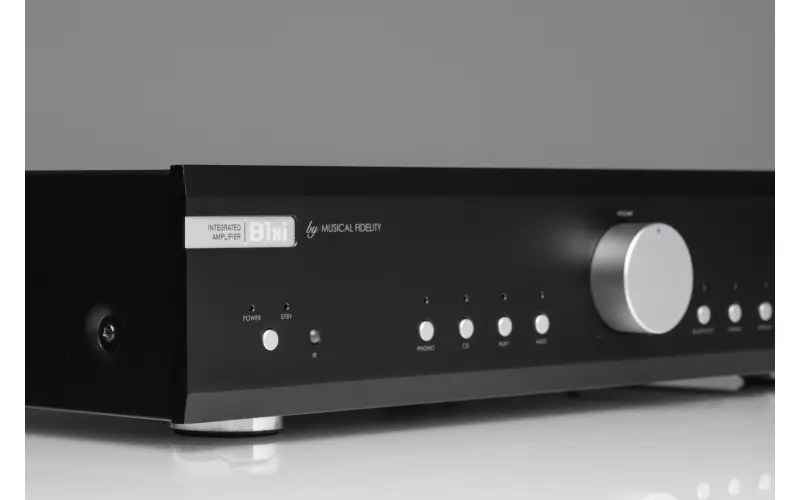By: Dipin Sehdev
In a world increasingly dominated by smart devices and seamless digital integration, Musical Fidelity is taking a bold, some might say defiant, stance with its latest integrated amplifier, the B1xi. This new entry marks the revival of its esteemed B-Series, drawing heavy inspiration from the original B1 that graced the audio scene in the 1990s. The core philosophy? Unadulterated analog simplicity, shunning displays, Wi-Fi, and integrated streaming in favor of what the company champions as long-term reliability and pure audio performance.
But in an era where consumers expect an app and instant access to a universe of streaming content, is this stripped-down approach a stroke of genius or a step out of sync with modern demands?
Specs at a Glance: The B1xi’s Analog Heartbeat
The B1xi is, at its core, a testament to traditional amplifier design. Musical Fidelity has poured its resources into robust power delivery and high-quality analog components, aiming for a no-compromise sound.
Power and Amplification
-
Output Power:
-
60W per channel into 8 ohms
-
100W per channel into 4 ohms
-
Up to 140W per channel into 2 ohms
-
-
Amplifier Design: Fully discrete Class A/B
-
Transformer: Hefty toroidal transformer for stable power delivery
-
Power Supplies: Separate linear power supplies for the preamp, power amp, and digital sections, minimizing interference.
This power profile is more than adequate to drive a wide range of loudspeakers, even those with demanding impedance characteristics. The dedicated power supplies are a significant highlight, ensuring each section operates optimally without crosstalk or noise contamination—a crucial detail for audiophiles who prioritize signal purity.
Preamplifier and Analog Prowess
-
Preamplifier: Dedicated linear power supply
-
Volume Control: Old-school, motor-driven analog knob, maintaining an all-analog signal path
-
Phono Stage: Built-in Moving Magnet (MM) phono stage, tuned for low noise and high gain
-
Pre-out: Included for subwoofer integration or bi-amping configurations
The commitment to an analog volume control is a deliberate choice, preserving signal resolution that can sometimes be compromised by digital volume implementations. The integrated MM phono stage is a welcome addition for vinyl enthusiasts, offering a convenient, high-quality solution without the need for an external phono preamp.
Digital Connectivity (Limited, but Present)
While largely analog-focused, the B1xi does acknowledge the reality of digital sources with a select suite of inputs:
-
Digital Inputs:
-
Coaxial
-
Optical
-
HDMI ARC (Audio Return Channel)
-
Bluetooth 5.1
-
-
DAC Chip: ESS9018 (same as found in Musical Fidelity’s higher-end digital gear)
-
Isolation: All digital components are physically and electrically separated, with their own power supplies, to prevent interference with analog circuitry.
-
USB-C Output: 5V, for powering external streamers (not for audio playback)
The inclusion of HDMI ARC is particularly practical for integrating with modern TV setups, allowing the B1xi to handle TV audio. Bluetooth 5.1 offers a convenient, if not audiophile-grade, option for quick wireless connections from mobile devices. Crucially, Musical Fidelity has taken pains to isolate these digital inputs, ensuring they don't compromise the amplifier's core analog performance. The 5V USB-C output is a clever compromise, allowing users to add their preferred streaming solution (like a Wiim, Raspberry Pi, or Bluesound Node) without baking potentially obsolescent technology directly into the amplifier.
Build Quality and Design
-
Chassis: All-metal construction
-
Control Scheme: Maintains the brand’s traditional analog controls
-
Design Philosophy: Emphasizes long-term reliability and serviceability
The all-metal chassis speaks to durability, a hallmark of Musical Fidelity's design ethos. The brand's focus on serviceability is a nod to its legacy, where products from decades past continue to perform.
Availability and Pricing
The Musical Fidelity B1xi is slated for release in August 2025.
-
Price:
-
$879 USD
-
$1,229 CAD
-
This pricing positions the B1xi as an attractive option in the competitive integrated amplifier market, especially given its robust power and premium internal components.
The Elephant in the Room: No Streaming, No App
Here's where the B1xi truly deviates from the prevailing trends. In an era where even refrigerators connect to the internet, Musical Fidelity has deliberately stripped out built-in Wi-Fi, integrated streaming services, and a dedicated control app. This isn't an oversight; it's a core design principle championed by company principal Heinz Lichtenegger.
The argument is compelling from a certain perspective: streaming technology, digital displays, and app ecosystems evolve at a blistering pace. What's cutting-edge today can be obsolete tomorrow. Displays can fail, software can become unsupported, and the integrated "smart" features often come at the expense of investment in core audio components. By omitting these elements, Musical Fidelity claims it can allocate more resources to what truly matters for sound quality: transformers, amplification circuitry, and robust analog components. The company points to the longevity of its older products as proof that this approach pays dividends in terms of long-term investment.
Is This the Right Move? A Modern Dilemma
While Musical Fidelity’s reasoning for focusing on pure analog performance and long-term reliability is understandable, it immediately raises questions about its relevance in today’s interconnected world.
The Customer Expectation Gap
Today's consumer, especially those new to hi-fi, often expects a seamless, integrated digital experience right out of the box. Consider the typical journey:
-
Music Discovery: Primarily through streaming services like Spotify, Apple Music, Tidal, or Qobuz.
-
Control: Via intuitive smartphone apps that offer search, playlist management, and multi-room audio capabilities.
-
Connectivity: Wi-Fi and Ethernet are the backbone of modern home audio, enabling high-resolution streaming and network integration.
The B1xi, with its lack of an app and integrated streaming, requires users to bring their own digital solutions. While the 5V USB-C output for an external streamer is a thoughtful compromise, it adds complexity and an extra box to the setup. For someone accustomed to the plug-and-play simplicity of Sonos or even a modern AV receiver with built-in streaming, this might feel like a step backward.
The Streaming Imperative
Streaming isn't just a convenience; it's how many people consume music exclusively. The ability to instantly access millions of tracks, create personalized playlists, and discover new artists without ever leaving an app has become the default. An amplifier that forces users to rely on external dongles or separate devices for this fundamental capability might alienate a significant portion of the market.
While audiophiles might appreciate the ability to choose their preferred streamer and upgrade it independently, the mass market prefers simplicity. The "just works" factor is paramount. The B1xi's approach, while technically sound, could be perceived as less user-friendly for anyone not already steeped in the nuances of external digital audio transport.
The Longevity Argument vs. Feature Deprivation
Musical Fidelity's argument about avoiding obsolescence holds weight. Indeed, a well-built amplifier's core functionality can last for decades. However, the rapidly evolving landscape of digital audio means that even if the amplifier's internal components remain robust, the external streaming ecosystem could drastically change. The dedicated digital inputs (coaxial, optical, HDMI ARC, Bluetooth) provide some flexibility, but they don't replace the convenience of true network audio.
One could argue that if a user invests in a high-quality external streamer, they are still subject to that streamer's potential obsolescence. The difference is that a separate streamer is typically far less expensive to replace than an entire integrated amplifier, and its "obsolescence" is often about software support or new codec compatibility rather than a fundamental hardware failure.
Who is the B1xi For?
Despite these reservations, the B1xi isn't without its appeal. It targets a specific niche of audiophiles and music lovers who:
-
Prioritize Pure Analog Sound: For those who believe that less digital interference equals better sound, the B1xi's focus on discrete Class A/B amplification, robust power supplies, and a pure analog preamp is a strong draw.
-
Are Vinyl Enthusiasts: The high-quality built-in MM phono stage makes it an excellent choice for turntable users looking for a straightforward, high-performance solution.
-
Prefer Simplicity Over Features: For listeners who want to put on music and simply enjoy it, without getting bogged down in apps, firmware updates, or complex network configurations.
-
Have Existing Streaming Solutions: Many audiophiles already own dedicated streamers (e.g., a high-end DAC with streaming capabilities, or a network audio player). The B1xi allows them to integrate their existing or preferred digital source without paying for redundant features.
-
Value Durability and Long-Term Investment: The emphasis on robust build quality and serviceability appeals to those looking for an amplifier that will last for many years.
Conclusion: A Niche Gem in a Digital World
The Musical Fidelity B1xi is a fascinating product. It's a defiant nod to the past, prioritizing tried-and-true analog engineering and long-term reliability over the fleeting trends of integrated digital features. For the audiophile who values pristine analog performance, has a collection of physical media (especially vinyl), or already possesses a preferred external streamer, the B1xi presents a compelling package at a competitive price. Its robust power, quality components, and classic control scheme are undeniably appealing.
However, for the broader market—and particularly for younger consumers accustomed to integrated streaming, app control, and the "smart home" ecosystem—the B1xi's deliberate omission of these features could be a significant hurdle. It requires a conscious decision to embrace simplicity and to fill in the digital blanks with external devices.
Ultimately, the B1xi is not trying to be everything to everyone. It's a specialized tool for a specific kind of music lover. Whether its old-school charm can carve out a meaningful space in a digitally saturated market remains to be seen, but one thing is clear: Musical Fidelity is sticking to its guns, and for some, that's exactly what they're looking for.




